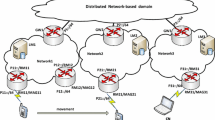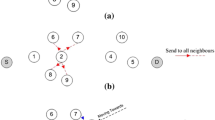Abstract
By the increased number of mobile devices, the demand of high speed connection oriented tunneling networks also increases. But, in mobile tunneling networks, the full route will have to be reconstructed more frequently because of more frequent route failures, where the requirements for extra route reconstructions (RRC) will cause extra delay and a decreased system throughput. In this work, a novel routing algorithm, optimum path routing (OPR) is proposed to extend the route life time of mobile multi hop tunneling networks and to increase the system throughput. On the other hand, as the most recent works in the literature indicate that, one of the greatest challenges of tunneling networks is to provide the network flexibility by instant adaptation on changing network conditions to keep the delay at lowest levels even in case of high traffic loads or node failures. To solve the aforementioned flexibility problem of the tunneling networks, a novel algorithm applicable to all kinds of routing algorithms called “avoid congested nodes (ACN)” is proposed. The results show that, the OPR algorithm proposed to increase the route life has succeeded in decreasing the RRC delay by 84% and improving the throughput by 20.17% with respect to the Fastest Path routing algorithm in the literature. And the ACN algorithm, proposed to provide a rapid adaptation of the nodes to the changing traffic conditions, has also succeeded in carrying back the throughput of the network with traffic load from 75.5% of its best performance evaluated with no traffic to its 94%.



















Similar content being viewed by others
References
Preveze, B., & Safak, A. (2010). Comparative analysis of novel long life routing methods in mobile networks. In PIMRC 2010 (pp. 1596–1601).
Huang, S.-C., & Shie, D.-C. (2010). A long-life, shortest path routing algorithm for wireless inter-vehicle networks. In 13th international conference on network-based information systems, 2010 (pp. 9–13).
Gui, C., Sun, B., & Xia, C. (2008). An entropy-based long-life multipath routing algorithm in MANET. In 2008 fourth international conference on natural computation, 2008 (Vol. 5, pp. 174–178).
Yi, X., & Wanye, W. (2008). Finding the Fastest Path in Wireless Networks. In IEEE ICC 2008 (pp. 3188–3192).
QasimYaseen, N. (2015). Performance comparison of routing algorithms used in packet switching computer networks. M.Sc. Thesis. Cankaya Univ., Computer Engineering, 2015.
Ridwan, M. A., Radzi, N. A. M., Ahmad, W. S. H. M. W., Abdullah, F., Jamaludin, M. Z., & Zakaria, M. N. (2020). Recent trends in MPLS networks: Technologies, applications and challenges. IET Communications, 2020, 177–185.
Haddaji, N., Nguyen, K., & Cheriet, M. (2018). Towards ete integrated optical packet network: Empirical analysis. Optical Switching and Networking, 27, 18–39.
Adewale, A. A., Adagunodo, E. R., John, S. N., & Ndujiuba, C. (2016). A comparative simulation study of IP, MPLS, MPLS-TE for latency and packet loss reduction over a WAN. International Journal of Networking and Communications, 6(1), 1–7.
Wyld, D. C., Zizka, J., & Nagamali, D. (2012). Advances in computer science, engineering and applications. Berlin: Springer. ISBN 978-3-642-30110-0.
Abed, S., MazenKharbutli, B. J., & Mohd, S. A. (2014). MPLS technology in wireless networks. Wireless Network, 2014, 1037–1051.
Iannone, E. (2012). Telecommunication Networks. Boca Raton: CRC Press/Taylor and Francis Group. ISBN 978-1-4398-4636-0.
Moizuddin, M., & Shaikh, M. (2004). Understanding convergence in MPLS VPN networks. Cisco Systems, Session: RST-2606.
Stutzman, W. L., & Thiele, G. A. (2012). Antenna theory and design. New York: Wiley. ISBN 978-0-470-57664-9.
Author information
Authors and Affiliations
Corresponding author
Additional information
Publisher's Note
Springer Nature remains neutral with regard to jurisdictional claims in published maps and institutional affiliations.
Rights and permissions
About this article
Cite this article
Preveze, B. A Novel High Performance Routing Algorithm for Mobile Multi-hop Tunneling Networks. Wireless Pers Commun 114, 1–27 (2020). https://doi.org/10.1007/s11277-020-07257-7
Published:
Issue Date:
DOI: https://doi.org/10.1007/s11277-020-07257-7




